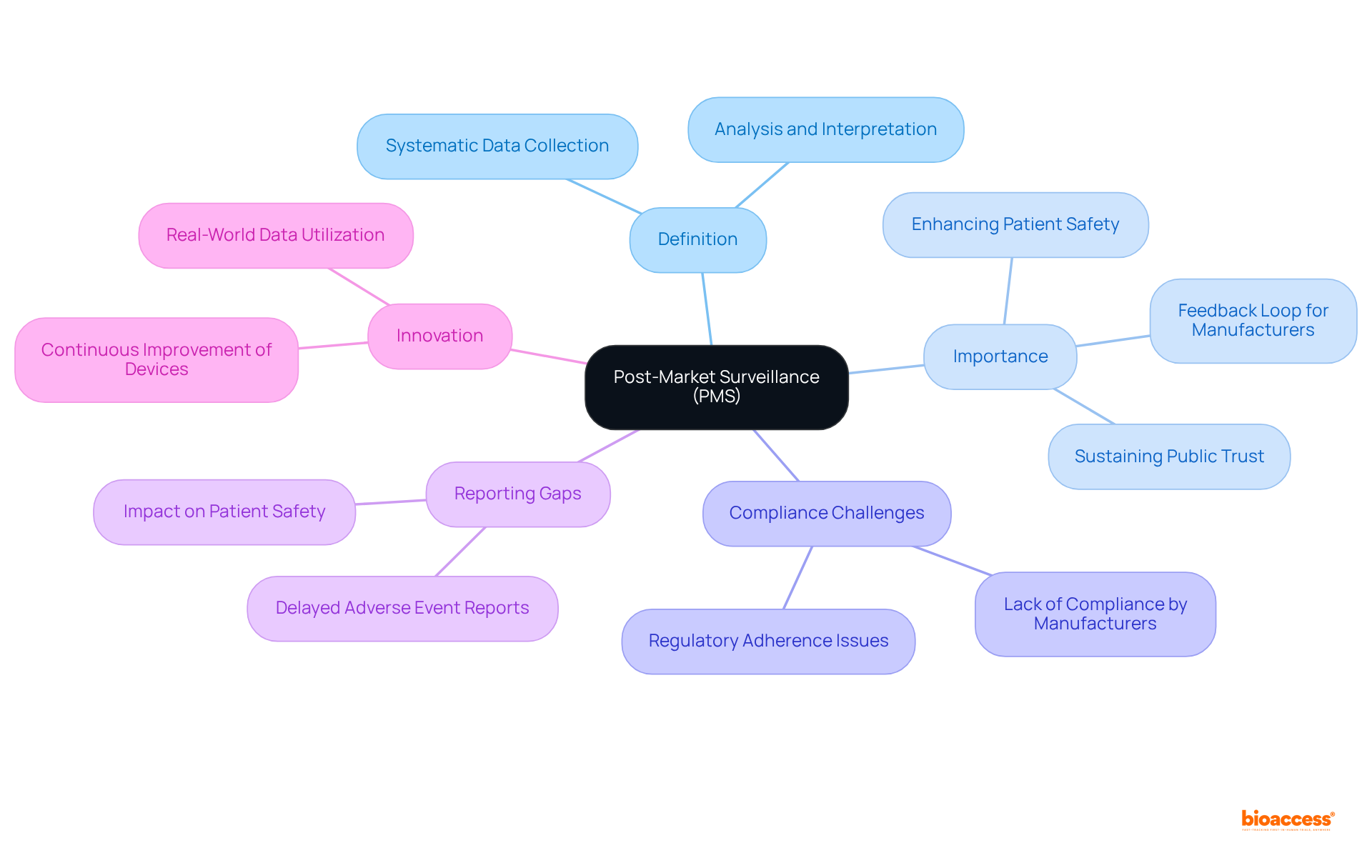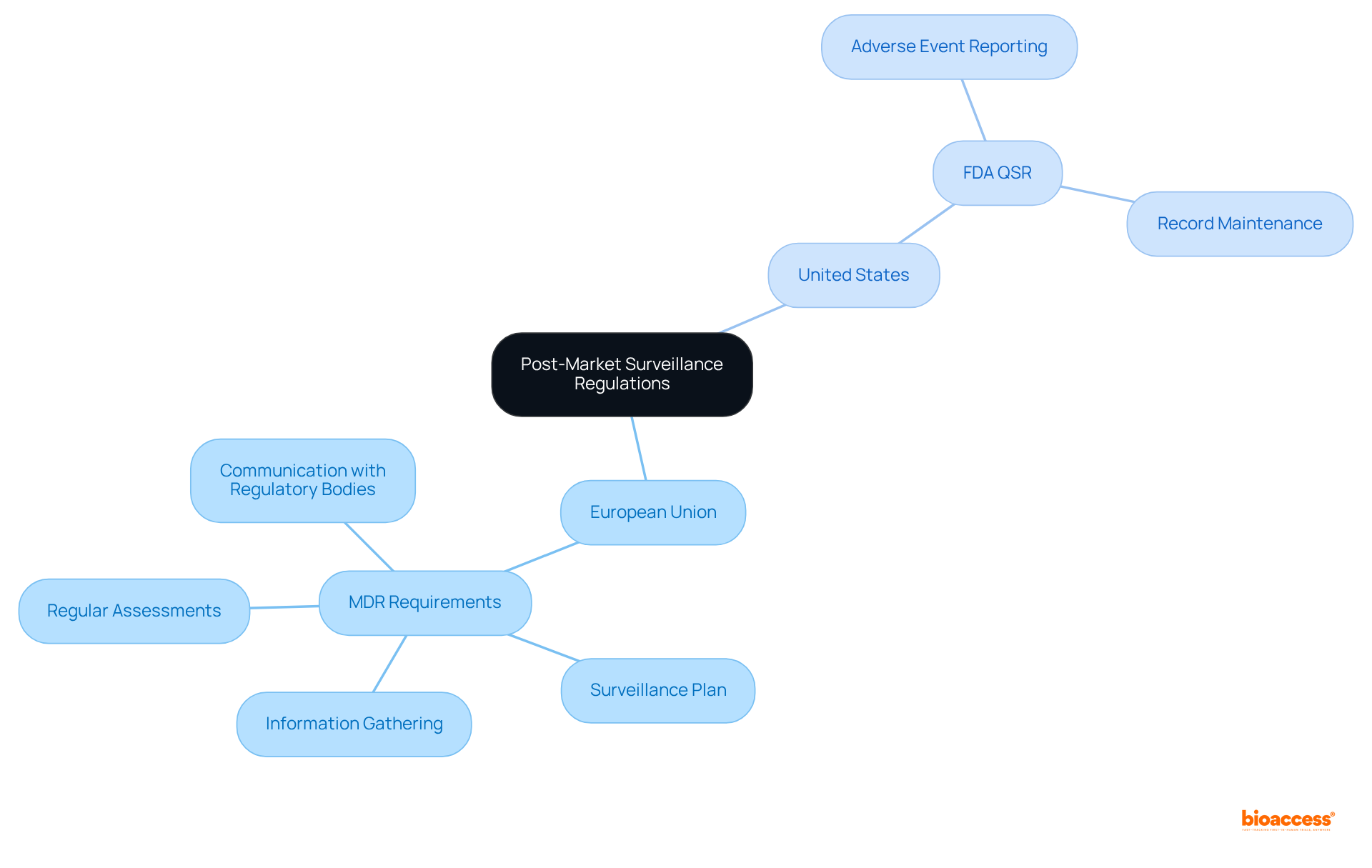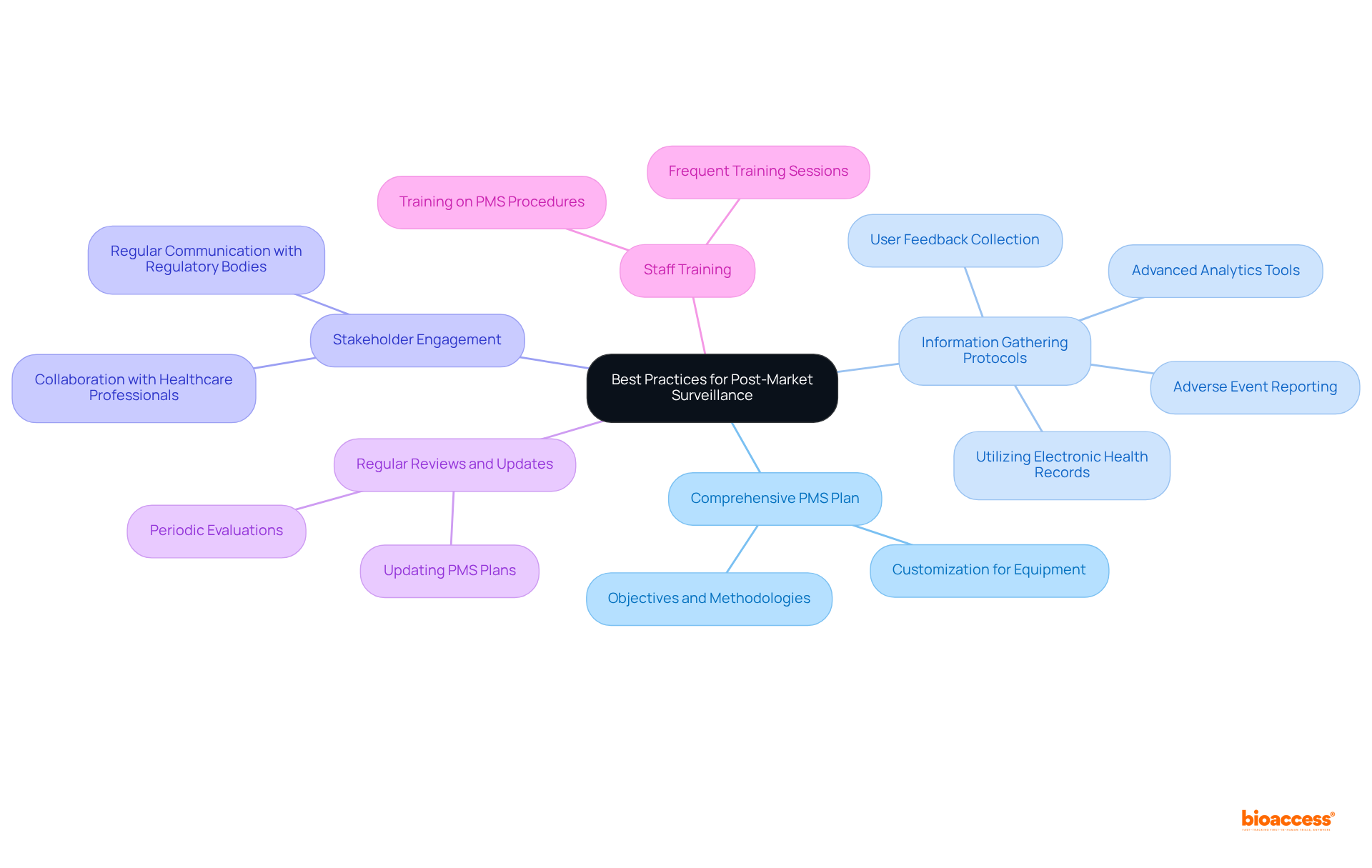


This article delineates five pivotal strategies for effective post-marketing surveillance (PMS) of medical products, underscoring its critical role in ensuring product reliability and safeguarding patient safety. It articulates the necessity of:
Each of these strategies is essential not only for regulatory compliance but also for enhancing the overall effectiveness of medical devices. As the landscape of clinical research evolves, the importance of these strategies becomes increasingly evident, necessitating a proactive approach to PMS that fosters collaboration and innovation.
Post marketing surveillance (PMS) represents a crucial yet frequently overlooked component in the lifecycle of medical devices. It serves as a vital mechanism for ensuring product reliability and patient safety long after market introduction.
By adopting effective PMS strategies, organizations can not only comply with regulatory requirements but also harness valuable insights that drive continuous improvement and innovation in medical technologies.
However, alarming statistics reveal significant gaps in compliance and reporting. This raises an essential question: how can manufacturers effectively navigate the complexities of PMS to enhance both safety and public trust in their products?
Post marketing surveillance (PMS) represents a systematic approach to the collection, analysis, and interpretation of data concerning the reliability and efficacy of medical products after their market introduction. This essential process is pivotal for identifying potential issues that may arise during the use of devices in real-world settings. PMS enables manufacturers and regulatory bodies to monitor the performance of medical equipment, ensuring compliance with standards and expected functionality. By implementing robust PMS strategies, organizations can proactively manage adverse events, thereby enhancing patient safety and sustaining public trust in medical technologies.
The significance of PMS is profound; it acts as a critical feedback loop that informs manufacturers about the long-term performance of their products. Such insights are vital for making necessary adjustments, conducting recalls when required, and ensuring adherence to regulatory requirements. Notably, the Dutch Health and Youth Care Inspectorate revealed that none of the medical equipment manufacturers under review fully complied with PMS mandates, underscoring considerable challenges in regulatory adherence. Additionally, nearly one-third of adverse event reports related to medical equipment submitted to the FDA are delayed, often exceeding six months post-initial notification. This reporting gap underscores the urgent need for robust PMS practices to safeguard patient safety and ensure the effectiveness of medical instruments.
Moreover, PMS fosters innovation by supporting the continuous improvement of medical equipment. By analyzing real-world data, manufacturers can discern trends and patterns that inform product enhancements, ultimately leading to improved patient outcomes. Recent advancements in PMS methodologies, such as the FDA's initiative to leverage structured real-world data for monitoring equipment reliability, illustrate the dynamic nature of post-market oversight. As Irina Smith articulated, 'Discover how the FDA is utilizing real-world information to proactively oversee equipment reliability and what it signifies for patients, providers, and manufacturers.' These developments highlight the indispensable role of PMS in ensuring that medical instruments not only meet initial quality standards but also sustain effective performance throughout their lifecycle.

Regulatory requirements for post marketing surveillance vary across regions, yet they universally mandate that manufacturers establish and maintain a robust post marketing surveillance system. In the European Union, the Medical Device Regulation (MDR) necessitates that manufacturers develop a comprehensive post marketing surveillance plan. This plan must delineate the procedures for overseeing the protection and performance of medical equipment post-market release, encompassing the gathering of information on adverse occurrences, conducting regular assessments, and communicating results to regulatory bodies. Compliance with these regulations is critical; failure to adhere can lead to significant legal repercussions.
In the United States, the FDA enforces the Quality System Regulation (QSR), which includes requirements for post marketing surveillance. Manufacturers are obligated to report any adverse events and maintain thorough records of their post marketing surveillance activities. Recent changes to FDA guidelines underscore the importance of organized data gathering and evaluation, which are essential for ensuring product reliability and effectiveness. Statistics indicate that adherence rates to PMS regulations are improving, yet challenges remain, particularly for high-risk products that require stringent supervision.
By remaining informed about the evolving regulatory landscape, organizations can effectively implement post marketing surveillance strategies that not only align with legal obligations but also enhance patient safety and product reliability. This proactive approach is vital for fostering trust among healthcare professionals and regulatory bodies alike.

To implement effective post-market surveillance, organizations should adopt the following best practices:
Develop a Comprehensive PMS Plan: A well-structured PMS plan should clearly outline the objectives, methodologies, and timelines for monitoring performance. Customizing this plan to the particular equipment and its intended use is crucial for its effectiveness. As mentioned, post marketing surveillance plays a crucial role in ensuring the safety and effectiveness of medical equipment once they are accessible to the public.
Establish Clear Information Gathering Protocols: Organizations must define how information will be collected, encompassing adverse event reporting, user feedback, and clinical outcomes. Utilizing electronic health records and patient registries can greatly improve information gathering efforts, ensuring thorough insights into equipment performance. Incorporating advanced analytics tools can further improve early signal detection, identifying serious issues sooner than conventional methods.
Engage with Stakeholders: Working together with healthcare professionals, patients, and regulatory bodies offers valuable insights into device reliability and performance. Regular communication with these stakeholders is crucial for early identification of potential issues, fostering a proactive approach to risk management.
Conduct Regular Reviews and Updates: Periodic evaluations of PMS information are essential for identifying trends and making informed decisions. Organizations should be prepared to update their PMS plans based on new findings or regulatory changes, ensuring ongoing compliance and responsiveness to emerging challenges. Under ANVISA regulations, companies must submit periodic risk reports and promptly report adverse events to maintain compliance.
Train Staff on PMS Procedures: Ensuring that all team members are well-versed in PMS processes and their significance is crucial for effective implementation. Frequent training sessions not only ensure adherence but also improve information precision, ultimately aiding in enhanced patient protection and product quality. Companies with structured training programs report compliance rates exceeding 85%, highlighting the importance of ongoing education.

Data collection and analysis serve as the backbone of effective post marketing surveillance (PMS), which is a critical component in ensuring patient safety and product efficacy. Organizations must leverage a variety of data sources to achieve comprehensive insights, including:
As Geoffrey Moore aptly stated, 'information is absolutely crucial to making smart business decisions,' highlighting the importance of data in post marketing surveillance. By employing advanced information analysis techniques, organizations can uncover patterns and trends that may not be immediately visible. This analytical approach empowers manufacturers to make informed decisions regarding product modifications, recalls, or additional user training.
Moreover, we generate the equivalent of the volume held by the Library of Congress in its complete print collection three times each second, highlighting the vast amount of data available for analysis. Continuous improvement should be the cornerstone of post marketing surveillance activities, ensuring that medical devices not only comply with regulatory standards but also significantly enhance patient safety and outcomes. As Chip and Dan Heath observed, 'information is merely summaries of thousands of stories'; thus, effective communication of insights is vital for motivating action in post marketing surveillance.
Furthermore, organizations must remain vigilant against common pitfalls in information gathering and analysis, such as the importance of timely data collection, as emphasized by Marissa Mayer. This proactive approach ensures that medical devices not only meet regulatory standards but also contribute to improved patient safety and outcomes. Industry experts stress that the ability to analyze and act on data is essential for maintaining a competitive edge and fostering innovation in the Medtech sector.

Implementing effective post marketing surveillance (PMS) is essential for ensuring the ongoing safety and efficacy of medical products after their market introduction. Through a systematic approach to data collection and analysis, PMS not only identifies potential issues but also enhances patient safety and fosters public trust in medical technologies. By emphasizing the importance of compliance with regulatory requirements, organizations can proactively manage risks and adapt to the evolving landscape of healthcare.
The article outlines several key strategies for effective PMS, including:
These practices are critical for creating a robust PMS system that not only meets regulatory standards but also drives continuous improvement in product performance. By leveraging data from adverse event reports, user feedback, and clinical outcomes, organizations can gain invaluable insights that inform necessary adjustments and innovations.
In conclusion, the significance of post marketing surveillance cannot be overstated. As the healthcare landscape continues to evolve, embracing these best practices and prioritizing data-driven decision-making will be vital for manufacturers. By committing to effective PMS, organizations not only safeguard patient safety but also contribute to the advancement of medical technologies, ultimately improving health outcomes for all.
What is post-market surveillance (PMS)?
Post-market surveillance (PMS) is a systematic approach to collecting, analyzing, and interpreting data regarding the reliability and efficacy of medical products after their introduction to the market.
Why is PMS important?
PMS is crucial for identifying potential issues with medical devices in real-world settings, enabling manufacturers and regulatory bodies to monitor performance, manage adverse events, enhance patient safety, and maintain public trust in medical technologies.
How does PMS benefit manufacturers and regulatory bodies?
PMS provides critical feedback on long-term product performance, helps manufacturers make necessary adjustments, conducts recalls when needed, and ensures compliance with regulatory requirements.
What challenges are associated with PMS compliance?
A review by the Dutch Health and Youth Care Inspectorate indicated that none of the medical equipment manufacturers fully complied with PMS mandates, highlighting significant challenges in regulatory adherence.
What issue exists with adverse event reporting related to medical equipment?
Nearly one-third of adverse event reports submitted to the FDA are delayed, often taking more than six months post-initial notification, which emphasizes the need for improved PMS practices.
How does PMS contribute to innovation in medical equipment?
PMS supports continuous improvement by allowing manufacturers to analyze real-world data, discern trends, and make product enhancements, ultimately leading to better patient outcomes.
What recent advancements have been made in PMS methodologies?
The FDA has initiated efforts to leverage structured real-world data for monitoring equipment reliability, reflecting the evolving nature of post-market oversight.